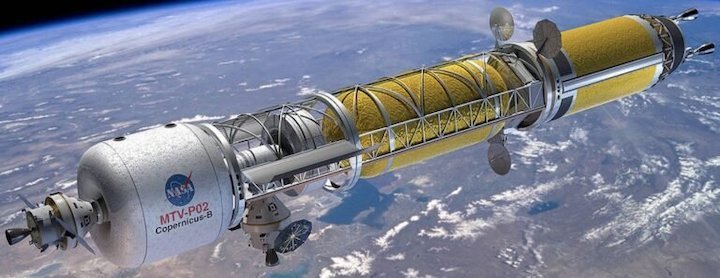19.02.2020
DARPA's budget documents say cislunar orbit is the "new high ground" at risk of being taken over by US adversaries.

NASA concept for a new rocket using nuclear thermal propulsion
WASHINGTON: DARPA has slated $158 million in its 2021 budget for space programs and technology, a basket of space-related programs that include its long-standing robotic servicing satellite effort and a new nuclear-fueled rocket for operations in deep space between Earth and the Moon.
DARPA’s 2021 funding request for space programs (PE 0603287E) is down $32 million from $190 million in 2020. This reflects the plan to wrap up the DARPA Launch Challenge competition to demonstrate a capability to rapidly launch small payloads to orbit, and the decision to terminate the Experimental Space Plane effort following the completion of the critical design review.
The sole remaining competitor in the $12 million DARPA Launch Challenge, California-based Astra, will make its first launch attempt sometime between Feb. 25 through March 1, program manager Todd Master told reporters today. It will then have to launch again from Kodiak Island in Alaska between March 18 and April 1. DARPA originally chose three competitors for the prize, but Virgin Orbit dropped out and Vector Launch went bankrupt last year. Astra will carry three different payloads on the first launch, including a DoD experimental cubesat called Prometheus to test rapid data dissemination to users on the ground.
Besides the flagship Blackjack program, the projects in DARPA’s space basket for 2021 include:
- Robotic Servicing of Geosynchronous Satellites (RSGS) — $46.3 million, a slight slip from $47.3 allocated in 2020. The RSGS program is aimed at establishing the capability to provide a variety of robotic services for satellites in GEO such as re-fueling or repairs. DARPA’s budget request says the program will be transitioned to a commercial partner who will provide the satellite to carry the robotic payload and operate it. DARPA has been looking at a launch date of 2022 for RSGS, after a series of problems that included the withdrawal last year of its commercial partner Maxar. The RSGS funds also support the Consortium For Execution of Rendezvous and Servicing (CONFERS) that brings together private sector and government experts to develop voluntary standards for on-orbit operations involving maneuverable satellites.
- Demonstration Rocket for Agile Cislunar Operations (DRACO), formerly known as “Reactor on a Rocket (ROAR)” — $21 million, up from an initial $10 million in 2020. DRACO “will develop and demonstrate a High-Assay LowEnriched Uranium (HALEU) nuclear thermal propulsion (NTP) system.” NASA is working on similar nuclear thermal propulsion rockets, which use low-enriched — between 5 and 20 percent — uranium-235 (U-235). U-235 is the basic nuclear fuel for commercial light-water reactors when enriched to between 3 and 5 percent; the Navy’s nuclear reactors use U-235 fuel enriched to 90 percent. The new rocket would allow the US military to operate spacecraft in cislunar space, which DARPA’s budget documents call the “new high-ground” that is “in danger of being defined by the adversary.” DARPA budget documents say the Air Force is the targeted customer for DRACO. As Breaking D readers know, senior Air Force and DoD officials are increasingly speaking publicly about the need for the United States to expand its military space activities to cislunar space to counter China — which has a robust civil lunar exploration program that many in the US national security community suspect is a cover for military ambitions. Indeed, SDA’s planned space architecture includes sensors in cislunar space. DARPA’s funding boost for the project reflects its intentions to move from feasibility studies this year to an actual demonstration in a testing environment in 2021.
- Planer Imager — $12 million, up from $5 million in 2020. “The Planar Imager program seeks to disrupt the state-of-the-art in optical sensors by developing a lightweight, compact, affordable optical payload that can be integrated into a ride-share compatible satellite bus with equivalent imaging performance to current commercial conventional optical imaging satellites,” DARPA’s budget documents explain. “This technology will significantly lower the size, weight, power, and cost (SWaP-C) of high-resolution intelligence, surveillance, and reconnaissance (ISR) satellites enabling persistent coverage by an affordable satellite constellation and with a rapid reconstitution ability.” Further, the documents say, these small sensors could be carried on small satellites that could be deployed simultaneously by one launch vehicle — thus pushing down the price of launch. DARPA envisions this program eventually being taken up by the Air Force.
Quelle: Breaking Defense
